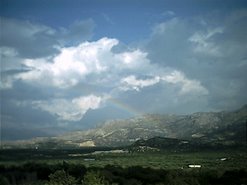David Bradley, Peer Gynt (1941)
Ξαφνικά μου ήλθε στο νου ο «Αραβικός χορός» από τον «Peer Gynt» του Έντβαρντ Γκριγκ. Τον άκουσα από το youtube, και σκέφτηκα ότι θα μπορούσα να δω και την ταινία.
Ο Peer Gynt είναι ένας ανεπρόκοπος νεαρός. Πειράζει τα κορίτσια, δεν έχει καθόλου καλή φήμη. Η Solveig αρνείται να χορέψει μαζί του όταν μαθαίνει ποιος είναι. Όμως δεν μπορεί να τον βγάλει από το μυαλό της.
Κλέβει τη νύφη τη μέρα του γάμου της και την πάει στο βουνό. Μετά την παρατάει, όπως έχει κάνει και με τόσες άλλες.
Στο βουνό κτίζει μια καλύβα. Εκεί τον βρίσκει η Solveig. Της λέει να τον περιμένει γιατί έχει να πάει πρώτα κάπου.
Μόλις που προλαβαίνει τη μητέρα του ζωντανή. Σε λίγο ξεψυχάει.
Μετά τον βρίσκουμε στην Αφρική, σε διάφορες περιπέτειες.
Διάβασα την πλοκή του θεατρικού έργου του Ίψεν από το λήμμα της βικιπαίδειας, για να πάρω μια ιδέα τι κράτησε απ’ αυτό ο Bradley.
Δεν μπορούσε να τα κρατήσει όλα.
Στο τέλος βλέπουμε τον Peer Gynt να επιστρέφει στην πατρίδα του. Η Solveig, πιο πιστή και από την Πηνελόπη, τον περιμένει.
Αρνητικός ο ήρωας, δεν νομίζω ότι θα είχα διάθεση να διαβάσω ή να δω και το θεατρικό έργο. Το έχω ξαναπεί, δεν μου αρέσουν έργα που ο ήρωας είναι αρνητικός χαρακτήρας.
Η ταινία χαρακτηρίζεται ως ερασιτεχνική, με τον 21χρονο σκηνοθέτη και τον 17χρονο πρωταγωνιστή, που δεν είναι άλλος από τον Τσάρλτον Ίστον, στην πρώτη του κινηματογραφική εμφάνιση.
Πολύ ωραίος νέος, όμως οι γονείς του θα έπρεπε να τον είχαν πάει σε ορθοδοντικό να του βάλει σιδεράκια.
Ερασιτεχνική ταινία μεν, όμως εξαιρετικά πρωτότυπη. Δεν υπάρχει περίπτωση να ξαναγυριστεί ταινία σαν αυτή.
Η πρωτοτυπία: παρόλο που γυρίστηκε το 1941 είναι βουβή ταινία, με μεσότιτλους.
Γιατί;
Διότι συνοδεύεται από την σουίτα του Γκριγκ, στην οποία αναφερθήκαμε. Δεν θα μπορούσε να υπάρξει καλύτερη μουσική επένδυση για ταινία.
Από τη σουίτα αυτή μου αρέσει ιδιαίτερα ο αραβικός χορός, τον οποίο είδαμε να χορεύει μια μαροκινή.
Την ταινία μπορείτε να τη δείτε στο youtube
Θεώρησα σκόπιμο να παραθέσω και τις πληροφορίες για την ταινία που βρήκα στο διαδίκτυο.
This is the
1941 amateur 16mm film adaptation of Henrik Ibsen's famous play Peer Gynt,
featuring 17-year –old Charlton Heston in his film debut. Furthermore a young
David Bradley was the director of this silent film being created for a
Northwestern University project. It was filmed in the Midwest on the northern
shores of Lake Michigan.
The film's opening title card reads: "Henrik Ibsen's Peer Gynt."
Although Peer Gynt was published in Copenhagen, Denmark in 1867, it was
not produced on the stage until Feb 1876, when it opened in Christiania,
Norway. Peer Gynt was made in 1941, as an independent experiment, welding
Ibsen's drama visually, and building the action of the play around the pulse
and mood of Grieg's music. A cast of non-professionals with little
theatre acting experience was employed. Locations in Northern Illinois and
Wisconsin, including the shores of Lake Michigan and a Norweigan-style village,
were utilized to achieve a remarkably authentic atmosphere. The production
bears evidence of influences from films such as Disney's Fantasia and
Reinhardt's A Midsummer Night's Dream, in its fusion of drama and music.
Peer Gynt was Charlton Heston's first screen role; he was then 17.
Both he and producer/director David Bradley went on to make other films
together, notably Julius Caesar made in 1950. Shortly after, both embarked
on separate Hollywood careers."
Although both Audrey Wedlock and Sarah Merrill are listed in the onscreen
credits as "Woman in Green," Wedlock plays the character as a young
woman and Merrill plays her after her transformation in to a hag. The film
was produced as an independent experiment by then-twenty-one-year-old
Northwestern University student David Bradley. Bradley shot the film
entirely in black and white, except for the section in the kindgom of "The
Boyg," which is tinted first green, then blue, and finally red when
"Peer" is under attack. According to an Aug 1941 Chicago
Tribune article, the cast and crew went without pay, and the film was shot
entirely on location in Starved Rock, Wisconsin Dells, Waukegan and Gary Dunes,
WI, as well as in Northern Illinois and Lake Michigan. According to a
1942 IP article, stock footage of "exotic locations" was used.
In 1941, upon being drafted into the Army, Bradley had to hurriedly wrap
post-production. Although the film had its premiere in its rough version
in Aug 1941, it was not until 1965 that Bradley was able re-edit the film the
way he desired and add new material, including the voice of silent movie star
Francis X. Bushman as "The Boyg." The credits for the 1965
version, which was released by The Willow Corporation, also include Katherine
Bradley, Anty Ball, Alice Badgerow, Robert Cooper, Rod Maynard and Jane
Willanovsky, but it has not been determined if these actors appeared in the
1941 version without credit, or appeared for the first time as part of the new
footage added to the 1965 version. The 1965 version also names Thomas A.
Blair and Roy Eggert, Jr. as associate producers.
.Charlton.Heston.Bradley.XviD.By.Neuromante.avi_snapshot_00.19.55.448.jpg)








No comments:
Post a Comment